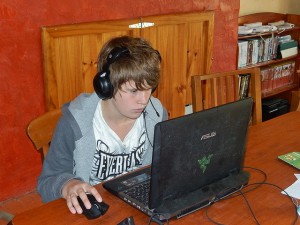
The prevalence of depression in young people is high and leads to significant impairment in young people’s lives. The National Institute for Health and Care Excellence (NICE) recommends CBT for mild/moderate depression for adolescents (NICE, 2005).
Demand for CBT exceeds supply and there is evidence that young people find services stigmatising. The adoption of a ‘stepped care’ (Bower & Gilbody, 2005) system has been implemented to overcome problems of access. Stepped care seeks to enhance the effectiveness of service delivery by providing low intensity ‘minimal interventions’ to a proportion of patients in the first instance. These interventions are generally described under the broad label of ‘self-help’ where CBT techniques are used by a patient and facilitated through a health technology such as written materials or computer programmes.
In adults, the NICE guidelines for depression recommend the provision of computerised CBT (cCBT) as an initial lower intensity treatment for depression as part of a ‘stepped care’ approach in primary care (NICE, 2009). A Health Technology Assessment (HTA) review of cCBT for depression in adults (Kaltenthaler et al, 2006) found preliminary evidence of clinical and cost effectiveness. However, the evidence base for cCBT (some of which are commercially produced and others are free to use) is mixed and there remains doubt about efficacy, cost effectiveness and acceptability.
The aim of the study was to evaluate the efficacy of Stressbusters, a computerised CBT (cCBT) programme for depression in young people (Smith et al, 2015).

NICE recommends cCBT for depression in adults, but doubt remains about efficacy, cost effectiveness and acceptability. Evidence for cCBT in young people has been limited before now.
Methods
This multi-site RCT compared cCBT (a commercially produced package called Stressbuster) to waiting list for mild/moderate depression in young people aged between 12-16.
Young people were screened for depression in 3 schools in the UK and those who met cut off for depression on the MFQ-C were interviewed and those who consented were randomised to either Stressbusters or waiting list. Stressbusters is a cCBT programme specifically designed for young people with mild to moderate depression. The study was sufficiently powered and outcomes were assessed at 3 and 6 months.
The primary outcome was depression symptoms measured by the Mood and Feelings Questionnaire – Child Report (MFQ-C). Secondary outcomes included the Child Responses Styles Questionnaire (CRSQ), parents were asked to rate the Mood and Feelings Questionnaire – Parent Report (MFQ-P) and Screen for Child Anxiety Related Disorders (SCARED-P) and teachers were asked to rate the Strengths and Difficulties Questionnaire (SDQ). School functioning data was collected via attendance and the numbers of pupils attaining grades A-C in English, Maths and Science.
Results
Of the 2,051 pupils enrolled across the 3 schools, 76% (n=1,554) were screened and of these 21% (n=331) scored above the cut off on the MFQ-C. In total 112 consented and were randomised to Stressbusters (n=55) and wait list (n=57).
- Key results found that compared to waiting list, cCBT showed clinically meaningful improvements in depression (controlled effect size 0.82) and anxiety at 3 months and maintained at 6 months.
- No differences were found between boys and girls.
- No difference was found between waiting list and cCBT on parent or teacher reported outcomes.
- No differences were found on educational improvement, but young people receiving cCBT had fewer absences from school than the wait list.

These are promising results for cCBT in young people with depression.
Conclusions
The study showed statistical and clinically meaningful change in depression and anxiety symptoms in young people aged 12-16 with mild and moderate depression and less school absences in those receiving cCBT as compared to waiting list. As predicted, the effect of cCBT was partially mediated by a reduction in ruminative thinking.
Strengths and limitations
There are a number of strengths to the study; it is the first UK RCT comparing cCBT with wait list in young people with mild/moderate depression. Of particular note is the adherence rate with 86% completing all 8 sessions. A further strength was that outcome was rated by multiple stakeholders (young people, parents and teachers as well as school attainment and absence).
The main limitations are that follow up was limited to 6 months which precludes answers to the effect of cCBT in the long term. A cost effectiveness analysis would have been beneficial. There was a relatively low uptake of cCBT with only 43% of eligible young people consenting to participate in the study. Relatively few teachers 20/55 and parents 12/55 completed the outcome measures at 6 months; this amount of missing data precludes any meaningful results.

Longer studies with better uptake of cCBT and better outcomes data are needed to confirm these promising findings.
Summary
This is the first UK RCT of cCBT in young people which demonstrated statistically and clinically meaningful improvements in depression and anxiety in young people with mild and moderate depression. The major strength is that cCBT was delivered via schools, the study potentially reduced stigma and therefore has significant promise of delivering an accessible, acceptable and evidence based intervention. Further research should focus on replicating this study with a cost effectiveness analysis.
Of note and relevant to this study is that a large RCT was published this week (n=691), which found cCBT to be ineffective in adults experiencing depression (Gilbody et al, 2015). A possible reason for the difference here is that young people find cCBT more acceptable than adults.

cCBT may work for young people with depression, but it’s looking less helpful for adults. The jury’s still out on cats…
Links
Primary paper
Smith P, Scott R, Eshkevari E, Jatta F, Leigh E, Harris V, Robinson A, Abeles P, Proudfoot J, Verduyn C, Yule W. (2015) Computerised CBT for depressed adolescents: Randomised controlled trial. Behav Res Ther. 2015 Oct;73:104-10. doi: 10.1016/j.brat.2015.07.009. Epub 2015 Jul 21. [PubMed abstract]
Other references
NICE (2005). Depression in children and young people: Identification and management in primary, community and secondary care. NICE Clinical guideline 28, 2005.
NICE (2009) Depression in adults: recognition and management. NICE Clinical guideline 90, 2009.
Bower P, Gilbody S. (2005) Stepped care in psychological therapies: access, effectiveness and efficiency. Narrative literature review. Br J Psychiatry. 2005 Jan;186:11-7.
Kaltenthaler E, Brazier J, De Nigris E, Tumur I, Ferriter M, Beverley C, Parry G, Rooney G, Sutcliffe P. Computerised cognitive behaviour therapy for depression and anxiety update: a systematic review and economic evaluation. Health Technol Assess. 2006 Sep;10(33):iii, xi-xiv, 1-168.
Gilbody S. et al (2015) Computerised cognitive behaviour therapy (cCBT) as treatment for depression in primary care (REEACT trial): large scale pragmatic randomised controlled trial. BMJ 2015;351:h5627 doi: 10.1136/bmj.h5627
Photo credits

Nicholas Smith interesting read. x
Is cCBT doing it for the kids, but not the adults? https://t.co/H0SCXIWdS1
Is cCBT doing it for the kids, but not the adults? https://t.co/ZzvYJuTWAx #MentalHealth https://t.co/KBp7TWHTwc
RT iVivekMisra Is cCBT doing it for the kids, but not the adults? https://t.co/lYsHDJTCpr #MentalHealth https://t.co/92OdkfBvqv
The is an interesting trial, but raises more questions than it provides answers. Most are issues with design – which will undoubtedly exaggerate the apparent efficacy of CBT
1) wait-list control is notoriously likely to exaggerate any effects – as Furukara and colleagues recently showed (2014) in a meta analysis (covered also on Mental Elf) http://www.nationalelfservice.net/treatment/cbt/its-all-in-the-control-group-wait-list-control-may-exaggerate-apparent-efficacy-of-cbt-for-depression/
2) In that context, it would have been nice to see the how the wait-list performed after receiving CBT and how many received it (I guess that’s for another paper)
3) The lack of blinding is an issue – especially with the discrepancies between childrens’ own ratings of (significant) change and those of teachers and parents/carers both showing none (though power is an issue no doubt). But why are the parents and teachers seeing no change, while the child seemingly does?
4) The lack of blind assessment coupled with wait-list control is especially compounding- as interestingly, the wait-list controls show almost no change in mean scores across time (which seems quite unusual in depression) – and as Furukara argue, it may be that wait list groups continue scoring as depressed ‘because’ they want to receive the intervention
5) finally, I find it extremely odd that only *one* of the wait-list children sought additional help – extrapolating from the their self-rated depression scores, over one-third have a depression score indicating probably ‘current major depressive disorder’ – is it not odd that only one child sought or was encouraged to seek help? Or were they not really quite that depressed?
Is cCBT doing it for the kids, but not the adults? https://t.co/dmcJ434Dwy via @sharethis
Is cCBT doing it for the kids, but not the adults? https://t.co/9QArWCZ8r0 via sharethis
RT @Mental_Elf: cCBT may work for young ppl w depression
Looking less helpful for adults
No RCTs for cats
https://t.co/fEdEWddn0P https://t…
“@Mental_Elf: cCBT may work for young ppl w depression
Looking less helpful for adults
https://t.co/tJIWr0HJmq https://t.co/ieZ3MHULSk”
Is cCBT doing it for the kids, but not the adults? https://t.co/Zvp7Kho8E9 via @sharethis
RT @BioethicsUoM: Evidence that computerised CBT might work for children, but not adults: https://t.co/UQhaTFb11w via @Mental_Elf – I wonde…
Today @karina_lovell appraises the first UK RCT of computerised CBT for depression in children & young people https://t.co/tOPE9tudKv
Is computerised #CBT doing it for the kids, but not the adults? https://t.co/sshwAoFXNF @Mental_Elf reviews an #RCT on #Stressbuster package
Is cCBT doing it for the kids, but not the adults? https://t.co/A1zGATNZoG via @sharethis
Is cCBT doing it for the kids, but not the adults? https://t.co/JykICm7xJY via sharethis
Is cCBT doing it for the kids? https://t.co/rxkPUMvm2q via sharethis
“NICE recommends cCBT for depression in adults, but doubt remains about efficacy, cost effectiveness and… https://t.co/5pTUESXthI
Is computerized CBT doing it for the kids, but not the adults? https://t.co/Q5HaXMiFto https://t.co/6gYO9BIvLK
Stressbusters cCBT shows promise for young people with depression https://t.co/tOPE9tudKv
Dale Thomson for your uni thing
Longer studies w better cCBT uptake & better outcomes data needed to confirm promising findings in young ppl https://t.co/tOPE9tudKv
Don’t miss: Is cCBT doing it for the kids, but not the adults? https://t.co/tOPE9tudKv #EBP
@Mental_Elf important work and a need to continually invest in evidenced based approaches for children @BABCP
Most popular blog this week? @karina_lovell Is cCBT doing it for the kids, but not the adults? https://t.co/tOPE9tudKv
@Mental_Elf @karina_lovell Oh, she is our colleague in @SNMSWResearch !
Is cCBT doing it for the kids, but not the adults? https://t.co/HnqN1FWXnI via sharethis
Is cCBT doing it for the kids, but not the adults? https://t.co/6DtePO5NVu via @sharethis
[…] K. (2015) Is cCBT doing it for the kids, but not the adults? The Mental Elf, 12 Nov […]
[…] studies suffer from low levels of engagement, but others don’t. For example, we blogged about an RCT of the Stressbusters programme, led by Patrick Smith from King’s College London and published last year in Behaviour Research […]